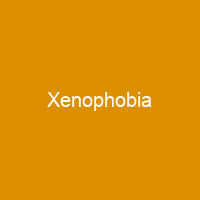Xenophobia: The Fear of the Foreign and Strange
Imagine a world where fear and suspicion reign supreme, where anything perceived as foreign or strange becomes an object of disdain and hostility. This is the essence of xenophobia—a term that encapsulates the deep-seated fear and dislike of anything deemed alien or unfamiliar. Is this fear justified? Or does it stem from irrational prejudices?
Ancient Roots
Xenophobia has ancient roots, manifesting in various forms throughout history. In ancient Egypt, hieroglyphics depicted a desire to conquer non-Egyptians, while the Greeks denigrated foreigners as ‘barbarians.’ The Romans viewed certain peoples as inferior and destined for slavery. These early examples illustrate how xenophobic attitudes have persisted through millennia.
Modern Manifestations
In contemporary times, xenophobia continues to shape societies in diverse ways. For instance, the sinophobia that emerged during the COVID-19 pandemic highlighted discrimination against people of East Asian and Southeast Asian descent worldwide. Similarly, the rise of hate crimes targeting Ontario Muslims after the Paris attacks underscored the ongoing threat of xenophobic violence.
In Colombia, over 1.3 million Venezuelan refugees faced exploitation, abuse, and xenophobia due to their situation. Meanwhile, racial tension exists between Indo-Guyanese and Afro-Guyanese populations in Guyana, with indigenous Mexicans facing discrimination despite improving economic conditions in Mexico. The historical persecution of Chinese and Japanese immigrants led to widespread xenophobia and violence.
Global Patterns
The global landscape is rife with examples of xenophobic attitudes. In the United States, civil rights organizations reported widespread discrimination against racial and ethnic minorities, with 76% of black and Asian respondents experiencing some form of discrimination. Bhutan deported an estimated 10,000 to 100,000 ethnic Nepalis (Lhotshampa) in 1991-92.
The Boxer Rebellion in China (1899-1901) was a violent anti-foreign, anti-Christian, and anti-imperialist uprising that promoted xenophobia. China’s defeat by Japan in 1895 led to widespread fear of foreign influence, with the Boxers attacking or murdering Christian missionaries and Chinese Christians.
In Europe, strong racial bias towards black people was recorded in several Eastern European countries. Negative views of Muslims have varied across the region, with Islamophobic hate crimes reported in Western Europe. In Belgium, over 100 antisemitic attacks were recorded in 2009, mostly perpetrated by young males of immigrant background.
Specific Cases
In Ukraine, an increase in antisemitic attacks was noted in 2017. The number doubled compared to the previous year. In South Africa, xenophobia has been a persistent issue since apartheid, including hostility towards Indians, Chinese, and foreign nationals. In 2015, xenophobic attacks against migrant Zimbabweans resulted in 7 deaths and over 2000 displaced foreigners.
The United Kingdom experienced varying levels of xenophobic attitudes, with the term ‘racism’ becoming more widespread after 1936. The EU survey found the UK to be the least racist among Western European countries surveyed. In Northern Ireland, sectarianism has been called racism due to widespread discrimination and violence.
Understanding Xenophobia
Xenophobia is not just a reaction to perceived threats; it often stems from deeper societal issues such as economic inequality, political instability, and cultural misunderstandings. How can we address these underlying factors?
The fear of the foreign and strange is deeply ingrained in human psychology, but it doesn’t have to define our interactions with others. By fostering greater understanding, empathy, and inclusivity, we can combat xenophobia and build more harmonious societies.

Xenophobia is a complex issue that requires nuanced understanding and concerted efforts to address. By recognizing its roots, acknowledging its impacts, and working towards inclusive policies and practices, we can create a world where everyone feels welcome and valued.
You want to know more about Xenophobia?
This page is based on the article Xenophobia published in Wikipedia (retrieved on March 10, 2025) and was automatically summarized using artificial intelligence.






